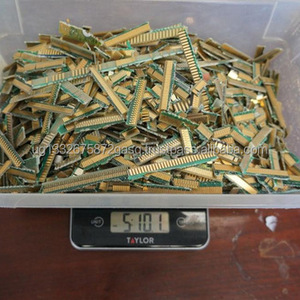
All categories
Featured selections
Trade Assurance
Buyer Central
Help Center
Get the app
Become a supplier

(19640 products available)












































The memory RAM scrap might come from different types of devices depending on when they were manufactured and the technology used. Here is a list of a few common types:
Dynamic Random Access Memory (DRAM)
The dynamic RAM is the memory card that uses semiconductor technology. It consists of a capacitor and transistor in each memory cell. The capacitor needs to be recharged or refreshed regularly because it leaks so that it can hold the information. The capacitor cell will store the 0's and 1's and the transistors will allow the reading and writing. This kind of memory is used in computer systems where large data storage is needed.
Synchronous Dynamic Random Access Memory (SDRAM)
The SDRAM is a newer generation of DRAM. Most of our computer systems will use SDRAM memory. The memory can run synchronously with the computer's clock speed, which allows faster processing and higher efficiency. The SDRAM comes in different sizes, like 64MB, 128 MB, 256 MB, 512 MB, and 1 GB, and different speeds, like 100 MHz, 133 MHz, 166 MHz, and 200 MHz.
Double Data Rate SDRAM (DDR SDRAM)
The DDR SDRAM works similar to SDRAM but transfers data on both rising and falling edges of the clock cycle. This means it can transfer data twice as fast as SDRAM. The DDR SDRAM comes in various sizes and speeds, just like the SDRAM.
Graphic Double Data Rate (GDDR)
The GDDR memory is designed specifically for graphics processing units or game consoles. It is optimized for high bandwidth so that data can be moved around quickly.
Video RAM (VRAM)
The VRAM is double-ported, which means data can be read and written at the same time. This is important for video adapters that need to process a lot of data quickly. The VRAM is optimized for storing image data like textures and frames.
Embedded DRAM (eDRAM)
The eDRAM has dynamic RAM and logic circuits on the same chip. This helps improve performance and reduces power consumption. Because of this, it is often used in handheld devices, mobile phones, and game consoles.
The functions of scrap memory RAM are to help the electronic recycling industry and to store information. Recyclers depend on memory RAM scrap to make more efficient products for the planet while maximizing the use of metals. It is believed that there are over 21 million tons of metals in landfill every year. Because metals can be recycled many times, using memory RAM to make new products will save companies time and resources.
The features of RAM scrap memory include the following:
The uses of scrap memory RAM are varied and innovative. Artists and crafters transform scrap into decorative pieces and art. From wall hangings made of RAM modules to jewelry pieces and key chains, the possibilities are endless. There is a thriving market for recycled art, and this is a good RAM scrap resale opportunity.
In the education sector, scrap can be used to teach students about computer hardware. Schools, training, and educational institutions can use RAM scrap to provide hands-on learning experiences in basic PC repair, disassembly, soldering, and electronics. Such programs create a work-ready technology workforce.
Businesses and enterprises can use memory scrap RAM to make branded desktop items, giveaways, and promotional products. Custom promotional products can have logos and brand messaging and are a cost-effective way to enhance brand visibility.
RAM scrap storage can be used to improve home entertainment systems. For example, old RAM modules can be combined to enhance basic functions of the entertainment system and engage hobbyists who enjoy tuning their systems.
Intel scrap job opportunities are in the e-waste recycling industry. An increasing number of companies are partnering with recyclers for responsible recycling solutions. RAM scrap recyclers can also work with companies looking to comply with environmental regulations and promoting sustainability.
At an individual level, people can turn old computer parts RAM into new furniture and home items, such as custom tables made from computer parts. This can be an entrepreneurial venture for creating unique furniture collections. Also, old CPU can be turned into cat condos and scratching posts for pet lovers.
Computer parts scrap stylized drawer pulls and cabinet handles. This adds a touch of geeky stylish home décor. As a result, they can also be sold as unique home improvement items.
OEMs (original equipment manufacturers) can use recycled RAM to create new products within the brand's product quality requirements. After proper recycling and refining, PC manufacturers can use RAM scrap to make new motherboards or memory modules.
The memory RAM scrap market can be lucrative. If one can find a reliable supplier, one can get high-quality scrap at a low price and make a good profit. However, to succeed in this business, one needs to know what type of scrap is in demand and the details of the refining process for each type. Understanding the refining process will help one learn how to treat the scrap and keep it in excellent condition. Many buyers are interested in specific types of scrap that can be easily refined, such as copper wire and aluminum cans. Knowing what is in demand will help one make good buying decisions and stock the right kind of scrap.
Find out how much local metal yards will pay for different types of scrap. This will give one an idea of the profit margin one can make. Choose a metal yard that pays a good price for the type of scrap one plans to sell. Make sure to sort the scrap properly before transporting it to the yard. Some yards may charge a fee for sorting the scrap, so it's essential to know the cost beforehand. Keep the scrap clean and dry to prevent rust or corrosion from forming. This will help maintain the quality and value of the scrap. Store it in a covered area or use tarps to protect it from rain or moisture. Using the right containers to keep the scrap organized and easy to handle is essential. This will also avoid any contamination or mixing of different types of scrap, which can reduce its value.
Q1: How can scrap RAM be stored until it is sold?
A1: It's important to keep scrap RAM modules in a dry, safe, and clean place. Choose an enclosed container that will prevent any form of dust from entering. Dust is a major turn-off for potential buyers.
Q2: What type of RAM sells fast?
A2: Generally, DDR3 and DDR4 RAMs are in high demand. But, keep in mind that other factors like physical condition and aesthetics can influence demand for a specific RAM type.
Q3: Is scrap RAM recyclable?
A3: Yes, scrap RAM can be recycled. In fact, recycling RAM scrap can help improve our environment by reducing e-waste. Additionally, recycling electronics like RAM can help recover precious metals like gold and copper.
Q4: What factors influence RAM scrap prices?
A4: Factors like market demand, metal content, and the physical condition of the RAM can influence pricing. Be sure to check the current market trends to find out how demand is affecting prices.
Q5: What is the scrap value of memory?
A5: The scrap value of memory depend on factors like the type of memory, quantity, and market demand. A PC memory scrap value might be around $3 to $15, but market demand will play a huge role in effectively selling at that price.